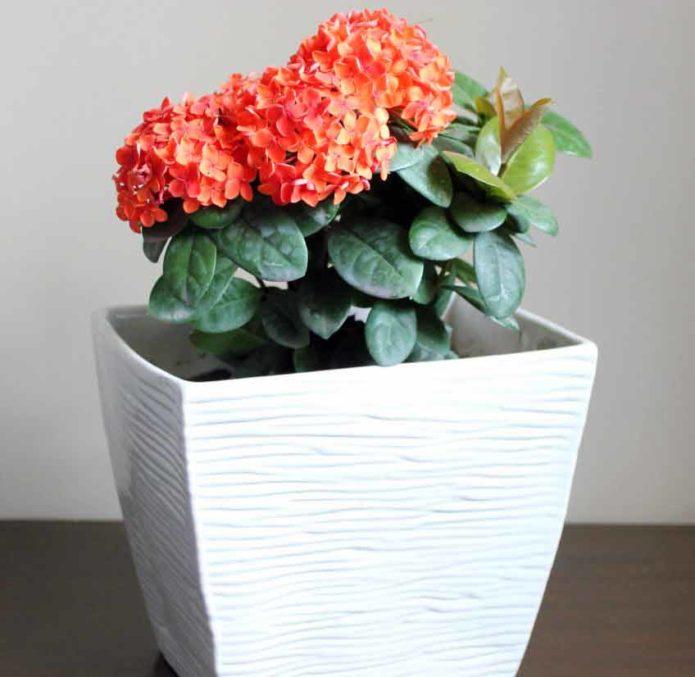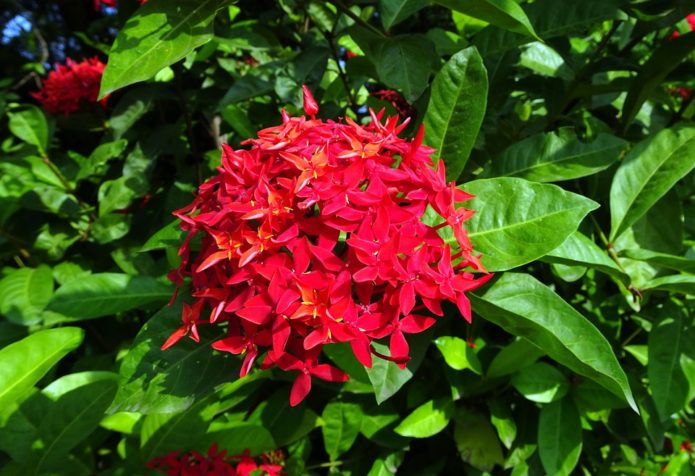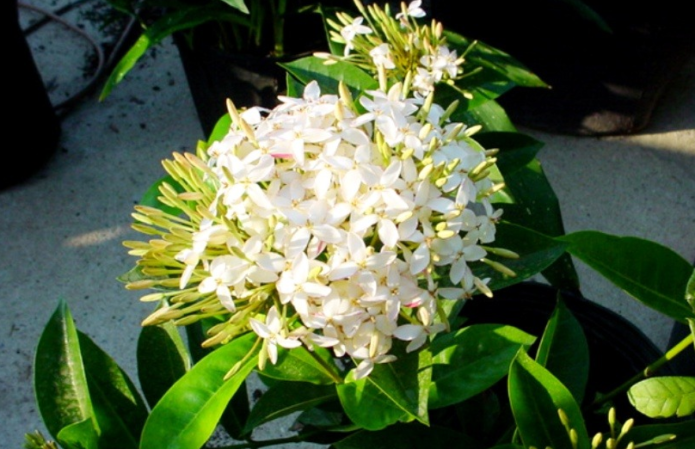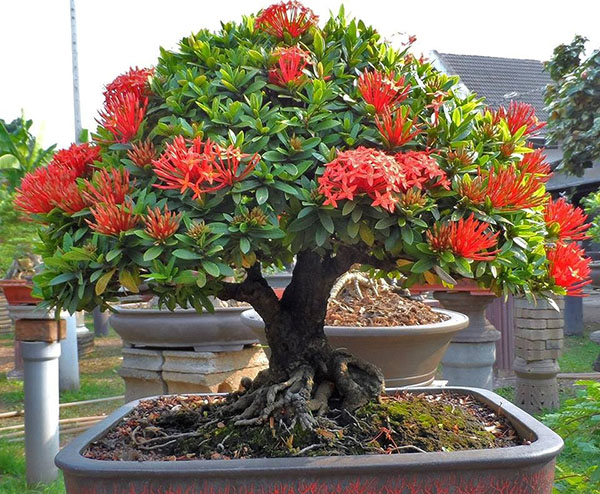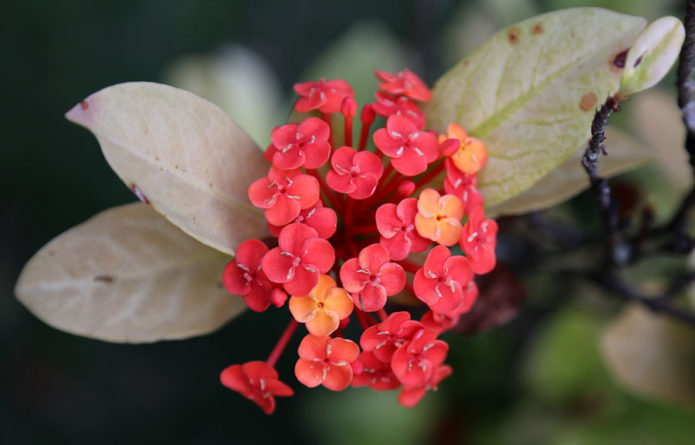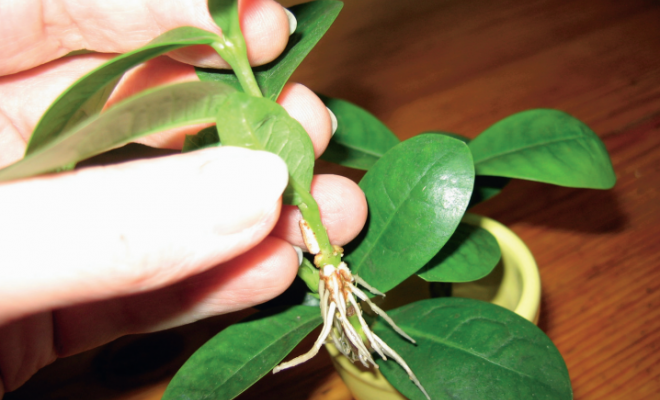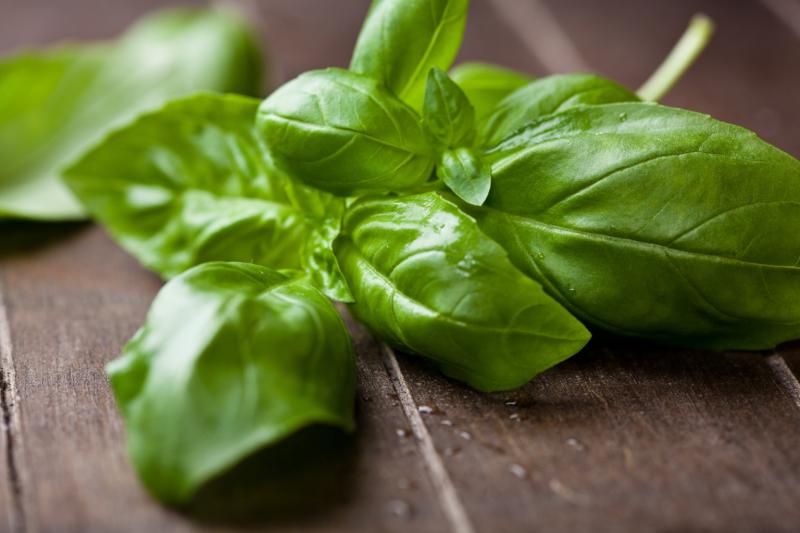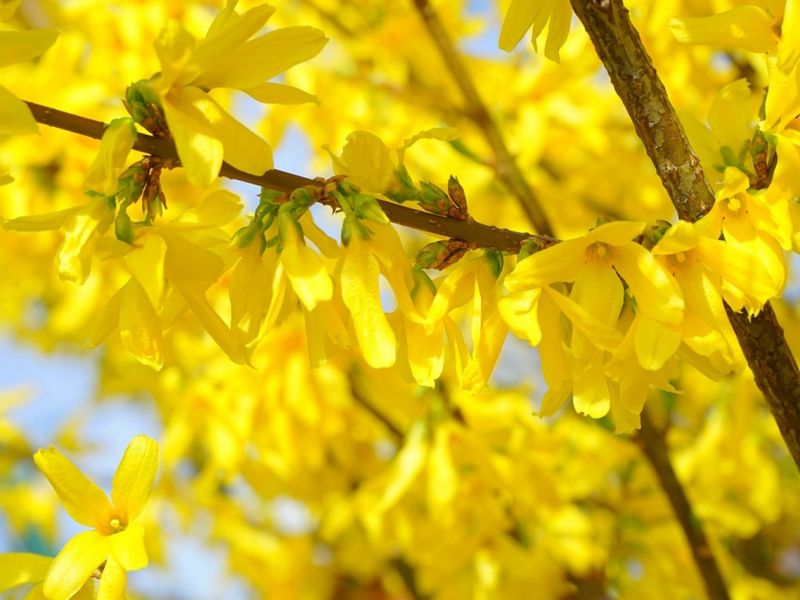Ixora is a tropical evergreen plant from the Marenov family. At home, it is called the "Flame of the Forest", which is due to the bright flowering against the background of glossy rich green foliage. This decorative flower is more successfully cultivated in gardens where the climate is warm. In Russia, it is mainly grown at home.
Content
Features of growing ixora
Ixora is a small tree or shrub with leathery, shiny oval or lanceolate leaves. Young leaves have a bronze tint, but with age they become monotonous green. The plant blooms with voluminous umbrella-shaped or spherical inflorescences, including many twisted flowers. They come in white, orange, pink, or red.
Under favorable conditions, Ixora blooms throughout the year. Moreover, she selects the time for this independently, depending on the temperature and lighting. The most colorful blooms are observed during the rainy season.
At home, the life expectancy of Ixora does not exceed a year, in a greenhouse (greenhouse, winter garden) - 2-5 years... After that, the flower's lower foliage crumbles and the overall appearance deteriorates.
It should be noted right away that growing Ixora is not an easy task, since the plant is very capricious. For his well-being, it is necessary to create the appropriate conditions:
- Optimum temperature: room + 19 ... 21aboutС, street + 23 ... 30aboutC. The plant is contraindicated in sharp temperature jumps and drafts. In summer, during the daytime, you can take it out on the balcony or in the garden.
- Sufficiently high soil and air humidity. The complete drying of the upper soil layer must not be allowed, which leads to leaf fall. This can be avoided by systematic spraying. It is advisable to place frequently watered plants next to the ixora, or place the pot on a pallet of wet gravel.
- A lot of light with shading from the midday heat. But even in partial shade, Ixora does not particularly suffer.
Popular varieties with photos
There are about 400 species of ixor, and thanks to selection, many varieties have been bred. True, a limited number of hybrids are cultivated in our country.
The most common varieties of Ixora:
- Bright red - a spectacular specimen up to one and a half meters high with bronze rounded leaves, pointed at the ends. It blooms with small buds of pink, scarlet, white or yellow.
- Javan is a shrub up to 1.2 m high. It has emerald glossy foliage of an ovoid configuration. It blooms with bright orange-red buds.
- Karmazinovaya is a meter-long representative of the genus with elongated (from 5 to 10 cm) green leaves and large-scale inflorescences of a bright purple color.
- Chinese - is a shrub up to 1 m tall. It has sharp-pointed leaves of a monochromatic rich green hue, and the flowers are yellow, red or snow-white.
Planting a plant
In the case of purchasing a germinated Ixora plant in a flower shop, it is important to carefully deliver it to its destination without negative consequences - Ixora is extremely sensitive to shaking. Young bushes adapt faster in the house than adults and flowering ones. Therefore, it is easier to independently grow Ixora from cuttings..
Usually this flower does not live for a long time in indoor conditions, but if you want to extend the period, it is necessary to immediately plant it in separate pots after purchase. Containers are selected that correspond to the size of the plant root system. It is advisable to take 2-3 cm more spacious than the old ones. In the future, they resort to transplanting annually (in February - March) for the first 5 years, and then only replace the top layer of soil. This is done until the overgrown roots become cramped and they begin to appear in the drainage holes.
For planting, you can buy a universal soil for decorative varieties or make it yourself. To do this, mix the following components in equal proportions:
- peat;
- river sand;
- leaf compost;
- sod land.
It is important that the soil is loose with a pH of 5–6. Ixora is contraindicated in alkaline soil, which leads to yellowing of foliage and inhibition of growth.
Planting sequence:
- A thick layer of drainage (up to 7 cm) of expanded clay or brick chips is laid on the bottom of the pot, then a little soil mixture.
- The plant is removed from the old container and, together with the earthy clod, is moved to a new place.
- Fill up the free space with soil.
After the procedure, the flower is watered and in the next two weeks they try to maintain high humidity. They begin to make top dressing no earlier than a month later.
Care after planting and flowering
It will be difficult for a novice florist to care for Ixora. The slightest blunders lead to a loss of decorativeness of the plant and a lack of flowering. Therefore, it is important to act competently:
- The plant is fed 2 times a month - in summer and 1 time - in winter. Use universal mineral formulations.
- Ixora is poured at least three times a week with cool water, which is pre-defended. The main thing is not to create swampiness, but drought is also contraindicated.
- Dried or damaged foliage and shoots are removed as needed. For this, a sharp and disinfected instrument is used.
- Periodically wipe the sheet plates with a damp cloth to clean them of dust.
- Ixora is not moved from the moment the buds are tied. Otherwise, they will fall off.
- After flowering, wilted inflorescences are cut off.
Ixora requires annual pruning not to stimulate flowering, but to enhance lateral branching and improve appearance. Often the plant is sold with an already formed crown. To maintain it, it is enough to periodically cut off excess shoots. In order for the plant to grow its green mass better, it is necessary to cut the leafy branches in half. This procedure is carried out after flowering. In early spring, too long shoots are shortened, and the tops of the rest are pinched.
What problems arise during growing, their solution
The capriciousness of the ixora flower is also manifested in terms of increased susceptibility to certain diseases. With poor care, chlorosis often occurs, in which the leaves turn yellow and deform. The plant is treated with additional podkomok microelements.It is also recommended to replace the substrate with another one with a higher acidity index. When the roots rot (occurs due to excessive watering and hypothermia), it will not be possible to save the old plant. You can get a new one from the cuttings.
Table: what difficulties can arise when growing a flower
| Non-standard manifestations | Causes |
| Buds fall | Unstable room temperature or sudden change in flower location |
| Curling and falling leaves | Reduced air humidity and prolonged exposure of the plant to direct sunlight |
| Exposure of stems at the bottom | Drying out of the soil or proximity to heating devices |
| Excessive stretching and thinning of shoots, leaves become pale | With a lack of light and improper watering |
| Poor flowering or lack thereof | Insufficient illumination |
All these problems are eliminated after the establishment of plant care.
Ixora is often attacked by pests: ticks and scale insects. You can get rid of them with the help of an alcohol solution, which is used to wipe the leaf plates and spray the room.
Reproduction
Ixora can be propagated by cuttings and seeds. The first option is most widespread, the second is applied mainly to species specimens. This is due to the fact that usually the original properties are not inherited by new plants.
Seeds
The procedure follows the classic scheme:
- They buy ready-made seeds or get them from the fruits of an existing flower. In the second case, they are first washed and soaked in water for 10 hours.
- A loose and nutritious substrate is poured into a suitable container.
- The seeds do not deepen much. Then they are sprinkled with earth, moistened with a spray bottle and covered with a film.
Optimum temperature for germination + 25 ... 27aboutFROM. The first shoots hatch in 2–3 weeks. As soon as 2 real leaves are formed on them, they resort to picking in separate pots.
Cuttings
The most favorable time for propagation by cuttings is spring, but usually the procedure is carried out after autumn pruning. Both apical and stem parts will do. It is important that live kidneys are present. Cuttings at the cut site are treated with Kornevin and placed in water or dripped into wet vermiculite. Put a plastic bag on top and place the branches in a warm place. In a maximum of 3 weeks, roots will appear, then the film protection is removed.
If during this time the cutting is artificially illuminated, then simultaneously with root formation it will grow.
Sprouted shoots are transplanted to a permanent place, after 2-3 months.
Indian traditional medicine uses Ixora flowers and leaves for their antiseptic properties. And with drugs from the roots of the plant, they treat fever and disorders of the digestive system, and also suppress toothaches.
